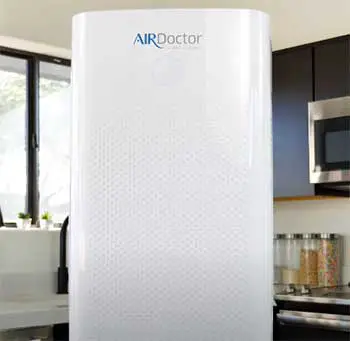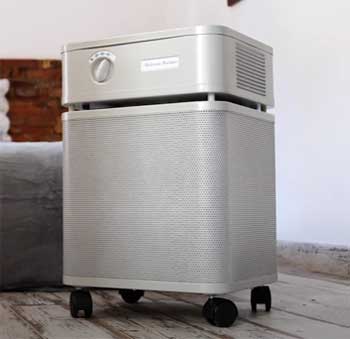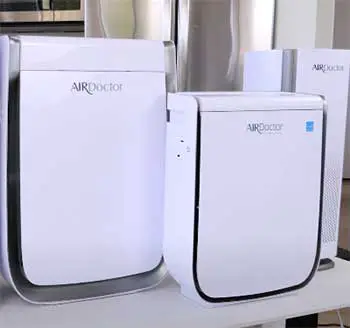Indoor air quality has become a growing concern for many homeowners as we spend more time inside our homes.
Air purifiers are an effective way to remove allergens, pollutants, and odors from the air to create a cleaner, healthier home environment. Two popular brands of air purifiers are AirDoctor and Austin Air.
But which one is the better choice? This comprehensive guide compares the key features, performance, pros and cons of AirDoctor and Austin Air purifiers to help you decide which model best fits your needs.
A Brief Comparison Table
| Features | AirDoctor | Austin Air |
| Technology | Uses patented SterilRayTM UV-C light technology plus HEPA filter | Relies on HEPA filtration and activated carbon |
| Coverage Area | Up to 1100 sq ft | Up to 1500 sq ft |
| Filters | Medical-grade H13 HEPA filter, activated carbon filter, UV-C sterilization | True medical-grade HEPA filter, activated carbon filter |
| Fan Speeds | Auto mode or 4 manual speeds | 3 speeds |
| Noise Level | 32 – 55 dB | 20 – 60 dB |
| Dimensions | 16.5 x 8.5 x 21.5 in | 23 x 14.5 x 14.5 in |
| Weight | 15 lbs | 18 lbs |
| Warranty | 1 year | 5 years |
| Price | $349 | $399 |
Key Differences Between AirDoctor and Austin Air
While AirDoctor and Austin Air both use proven HEPA filtration to capture airborne particles, they differ in their approach to air purification:

- UV-C Sterilization – The AirDoctor’s key differentiating feature is its patented SterilRayTM UV-C light technology. The ultraviolet light works to sterilize and deactivate airborne viruses, bacteria, and mold spores as air passes through the purifier. Austin Air relies solely on mechanical HEPA filtration without UV sterilization.
- Activated Carbon – Both air purifiers use activated carbon filters to adsorb odors, gases, and VOCs. However, the Austin Air has around 60% more activated carbon than the AirDoctor.
- Coverage Area – The Austin Air HealthMate Standard can handle larger rooms up to 1500 sq ft while the AirDoctor is rated for spaces up to 1100 sq ft.
- Noise Level – The Austin Air operates more quietly with noise levels as low as 20 dB on the lowest fan speed. The AirDoctor generates more audible white noise ranging from 32 – 55 dB on different fan speeds.
- Design – The AirDoctor has a more compact, cylindrical design suited to blend into room decor. The larger Austin Air unit has a square-shaped industrial look.
- Warranty – Austin Air provides a longer 5 year limited warranty compared to AirDoctor’s 1 year warranty.
Air Purifier Reviews: AirDoctor Pros and Cons
AirDoctor air purifiers are designed and engineered in Israel, home to some of the world’s leading UV technology experts. Here are the key pros and cons of the AirDoctor’s features and performance.
Pros:
- Medical-Grade Filtration – The 4-stage filtration uses an H13 HEPA filter that removes 99.97% of particles larger than 0.1 microns such as dust, pet dander, smoke, and mold.
- UV-C Sterilization – The SterilRayTM technology kills up to 99.9% of viruses, bacteria, fungi, and more according to lab testing. UV-C light destroys microorganisms and prevents them from replicating.
- Odor Reduction – Activated carbon filter adsorbs VOCs, smoke, and stubborn pet, cooking, and chemical smells.
- Auto Mode – AirDoctor automatically monitors air quality and adjusts fan speed accordingly to filter and circulate air.
- Compact Size – At 16.5 inches tall, the AirDoctor can fit in corners and smaller spaces while still handling rooms up to 1100 square feet.
- Quiet Operation – AirDoctor runs as low as 32 dB on the lowest fan speed so you can comfortably sleep or work.
Cons:
- No Timer – Lacks on-board timer to schedule when the purifier turns on/off.
- MediocreCADR Rating – Clean air delivery rate of 240 cubic feet per minute is decent but lower than other brands.
- Limited Air Changes per Hour – Can exchange air in a 889 sq ft room 2.5 times per hour on highest speed. Other models offer higher air changes.
- Minimalist Controls – Has a simple on/off button and fan speed dial rather than advanced LCD displays offered by competitors.
Austin Air HealthMate Pros and Cons
Engineered in America, Austin Air purifiers have been around for over 25 years. Here are the notable pros and cons of the Austin HealthMate model:
Pros:

- Large Carbon Filter – It contains over 15 lbs of activated carbon, more than most other brands, allowing for superior gas and odor removal.
- Extremely Quiet – The large activated carbon filter diffuses airflow to produce quiet operation as low as 20 dB even on high speed.
- High CADR Rating – With a clean air delivery rate of 350 cfm, it can filter high volumes of air quickly.
- Medical-Grade Filtration – True HEPA filter removes 99.97% of particles down to 0.3 microns in size.
- 5 Year Warranty – Backed by one of the longest warranties among major air purifier brands demonstrating durability.
Cons:
- No UV or Ionization – Lacks UV sanitization or ionizer found in other air purifiers for reducing viruses/bacteria.
- Big and Bulky – Large square design takes up more floorspace. Dimensions are 23 x 14.5 x 14.5 inches and 18 pounds.
- Manual-Only Operation – No smart sensors or auto mode. Fan speed must be adjusted manually.
- Higher Maintenance – Large HEPA filters plus 15+ pounds of activated carbon means higher ongoing filter replacement costs.
- Airflow Direction – Air enters and exits from the side rather than the top, which is less effective for air purification throughout a room.
Also Read: Is Rabbit Air Better Than AirDoctor Air Purifier?
Comparison of Specifications
Here is a detailed breakdown comparing the technical specs between the AirDoctor Professional and Austin Air HealthMate Standard models:
| Specs | AirDoctor | Austin Air |
| Dimensions | 16.5 x 8.5 x 21.5 in | 23 x 14.5 x 14.5 in |
| Weight | 15 lbs | 18 lbs |
| CADR Rating | 240 cfm | 350 cfm |
| Filters | HEPA, Activated Carbon, UV-C | HEPA, Activated Carbon |
| Filter Replacement | Every 12-15 months | Every 5 years |
| Coverage Area | Up to 1,100 sq ft | Up to 1,500 sq ft |
| Fan Speeds | Auto, 4 manual speeds | 3 manual speeds |
| Noise Level | 32 – 55 dB | 20 – 60 dB |
| Air Changes Per Hour | 2.5 (889 sq ft room) | 5 (500 sq ft room) |
| Airflow | 80 cfm (low) – 206 cfm (turbo) | 60 cfm (low) – 150 cfm (medium) |
| Power Usage | 53 watts (high) | 120 watts |
| Extra Features | SterilRayTM UV-C, Air Quality Sensor | None |
| Warranty | 1 year | 5 years |
As you can see, while both appliances effectively clean the air using proven HEPA and carbon filtration, the Austin Air model rates higher for volume of air purified and its whisper-quiet operation. Meanwhile, the AirDoctor offers germ-killing UV-C sterilization in a more compact design.
Which Air Purifier Is Better For You?
Choosing between the AirDoctor and Austin Air comes down to your priorities and needs:
Go with AirDoctor if you want:

- Germ, bacteria, and virus destruction from UV-C technology
- Compact and contemporary design
- Smart sensors with auto mode
- Lower upfront cost
Go with Austin Air HealthMate if you want:
- Superior gas, odor, and VOC removal from large carbon filter
- Very quiet operation even on high speed
- Larger room coverage over 1500 square feet
- Long-term filter life up to 5 years
While the Austin Air filters greater volumes of air, the AirDoctor offers the added sterilizing benefits of UV-C light. The Austin Air is ideal for large rooms and heavy-duty filtration needs.
But the sleek AirDoctor is a great versatile choice for medium-sized bedrooms and living spaces needing virus protection. Either way, you can rest assured you’re breathing cleaner indoor air.
Also Read: Is AirDoctor Better Than Puraclenz Air Purifier?
FAQ About AirDoctor and Austin Air Purifiers
AirDoctor is better for most homes because of its UV-C light that kills germs, compact size, smart auto mode, and lower price.
Winix uses plasmawave while Austin Air relies on carbon filters. Austin Air filters more air but Winix is smarter and more affordable.
Doctors often recommend HEPA models like Austin Air, IQAir, Blueair, and Winix that filter out dust, pollen, and other irritants.
Very quiet, only 20 dB on low which is softer than whispering. Even high speed is just 60 dB, comparable to humming or background music.
Wrapping Up
While Austin Air and AirDoctor take different approaches to air purification, both are excellent choices for removing allergens and improving home air quality. Austin Air’s larger filters and carbon filtration make it ideal for heavy-duty air cleaning in large spaces.
But AirDoctor offers a more compact design with the added benefit of UV sterilization to deactivate germs and viruses.
Consider your room sizes, filtration needs, noise preferences, and décor when deciding between these two quality air purifier brands. Maintaining clean indoor air brings major health advantages.
With its unique UV technology and intelligent auto mode in a smaller form factor, AirDoctor is the better choice for most homes, but Austin Air still leads for large rooms requiring robust filtration. Whichever model you choose, you can breathe easy knowing the air in your home is fresh and purified.
